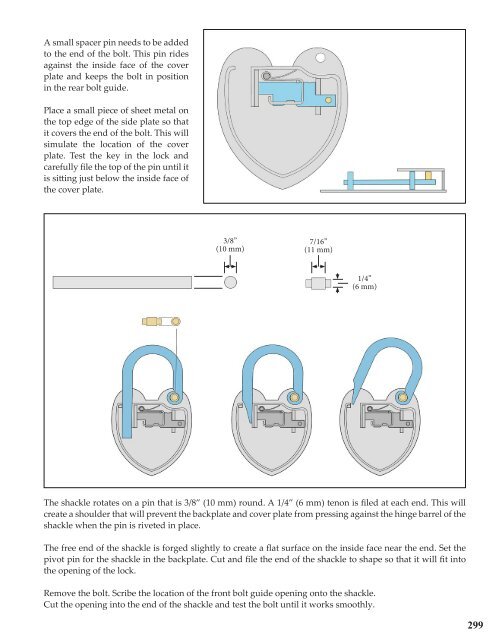The New Spruce Forge Manual of Locksmithing: A Blacksmith’s Guide to Simple Lock Mechanisms
The New Spruce Forge Manual of Locksmithing: a Blacksmith’s Guide to Simple Lock Mechanisms is a totally revised and expanded version of the original work from 1999. This new hardcover edition, at 304 pages and with more than 800 color photos and illustrations, is more than double the size of the original manual. It is divided into two distinct sections: Technical Information - This section is a reference manual in itself that covers the specific tools and techniques needed to build all the parts for each lock, as well as providing the information needed to understand the assembly instructions outlined in the second section. The Locks: Patterns & Instructions - This section provides the plans and detailed instructions for each of the 14 lock projects in this new edition. The clear assembly instructions describe when and how to use the technical information provided in section one. The authors have maintained their original trademark style that relies on well-illustrated step-by-step instructions that guide you through the whole lock-making process. They have also kept their low-tech approach that demonstrates how to go about creating good work using only a handful of simple tools. Making blacksmith locks is an age-old skill the authors of this manual are helping to preserve by passing on their knowledge to this book’s readers. The New Spruce Forge Manual of Locksmithing is also an excellent introduction to benchwork, which is a useful skill for any blacksmith to acquire. This manual will become a valuable, trusted and often referred to sourcebook in your blacksmithing library. Hardcover, 304 pages, more than 800 photos and illustrations.
The New Spruce Forge Manual of Locksmithing: a Blacksmith’s Guide to Simple Lock Mechanisms is a totally revised and expanded version of the original work from 1999. This new hardcover edition, at 304 pages and with more than 800 color photos and illustrations, is more than double the size of the original manual.
It is divided into two distinct sections:
Technical Information - This section is a reference manual in itself that covers the specific tools and techniques needed to build all the parts for each lock, as well as providing the information needed to understand the assembly instructions outlined in the second section.
The Locks: Patterns & Instructions - This section provides the plans and detailed instructions for each of the 14 lock projects in this new edition. The clear assembly instructions describe when and how to use the technical information provided in section one.
The authors have maintained their original trademark style that relies on well-illustrated step-by-step instructions that guide you through the whole lock-making process. They have also kept their low-tech approach that demonstrates how to go about creating good work using only a handful of simple tools.
Making blacksmith locks is an age-old skill the authors of this manual are helping to preserve by passing on their knowledge to this book’s readers. The New Spruce Forge Manual of Locksmithing is also an excellent introduction to benchwork, which is a useful skill for any blacksmith to acquire. This manual will become a valuable, trusted and often referred to sourcebook in your blacksmithing library.
Hardcover, 304 pages, more than 800 photos and illustrations.
You also want an ePaper? Increase the reach of your titles
YUMPU automatically turns print PDFs into web optimized ePapers that Google loves.
A small spacer pin needs <strong>to</strong> be added<br />
<strong>to</strong> the end <strong>of</strong> the bolt. This pin rides<br />
against the inside face <strong>of</strong> the cover<br />
plate and keeps the bolt in position<br />
in the rear bolt guide.<br />
Place a small piece <strong>of</strong> sheet metal on<br />
the <strong>to</strong>p edge <strong>of</strong> the side plate so that<br />
it covers the end <strong>of</strong> the bolt. This will<br />
simulate the location <strong>of</strong> the cover<br />
plate. Test the key in the lock and<br />
carefully file the <strong>to</strong>p <strong>of</strong> the pin until it<br />
is sitting just below the inside face <strong>of</strong><br />
the cover plate.<br />
3/8”<br />
(10 mm)<br />
7/16”<br />
(11 mm)<br />
1/4”<br />
(6 mm)<br />
<strong>The</strong> shackle rotates on a pin that is 3/8” (10 mm) round. A 1/4” (6 mm) tenon is filed at each end. This will<br />
create a shoulder that will prevent the backplate and cover plate from pressing against the hinge barrel <strong>of</strong> the<br />
shackle when the pin is riveted in place.<br />
<strong>The</strong> free end <strong>of</strong> the shackle is forged slightly <strong>to</strong> create a flat surface on the inside face near the end. Set the<br />
pivot pin for the shackle in the backplate. Cut and file the end <strong>of</strong> the shackle <strong>to</strong> shape so that it will fit in<strong>to</strong><br />
the opening <strong>of</strong> the lock.<br />
Remove the bolt. Scribe the location <strong>of</strong> the front bolt guide opening on<strong>to</strong> the shackle.<br />
Cut the opening in<strong>to</strong> the end <strong>of</strong> the shackle and test the bolt until it works smoothly.<br />
299










